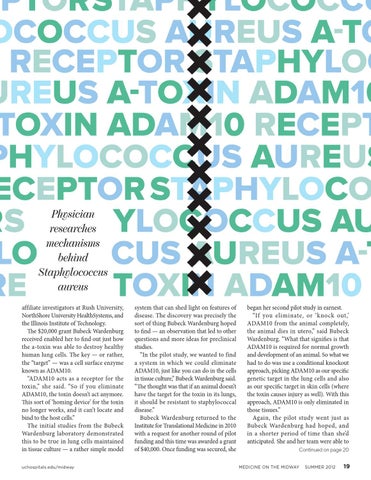Physician researches mechanisms behind Staphylococcus aureus affiliate investigators at Rush University, NorthShore University HealthSystems, and the Illinois Institute of Technology. The $20,000 grant Bubeck Wardenburg received enabled her to find out just how the a-toxin was able to destroy healthy human lung cells. The key — or rather, the “target” — was a cell surface enzyme known as ADAM10. “ADAM10 acts as a receptor for the toxin,” she said. “So if you eliminate ADAM10, the toxin doesn’t act anymore. This sort of ‘homing device’ for the toxin no longer works, and it can’t locate and bind to the host cells.” The initial studies from the Bubeck Wardenburg laboratory demonstrated this to be true in lung cells maintained in tissue culture — a rather simple model uchospitals.edu/midway
system that can shed light on features of disease. The discovery was precisely the sort of thing Bubeck Wardenburg hoped to find — an observation that led to other questions and more ideas for preclinical studies. “In the pilot study, we wanted to find a system in which we could eliminate ADAM10, just like you can do in the cells in tissue culture,” Bubeck Wardenburg said. “The thought was that if an animal doesn’t have the target for the toxin in its lungs, it should be resistant to staphylococcal disease.” Bubeck Wardenburg returned to the Institute for Translational Medicine in 2010 with a request for another round of pilot funding and this time was awarded a grant of $40,000. Once funding was secured, she
began her second pilot study in earnest. “If you eliminate, or ‘knock out,’ ADAM10 from the animal completely, the animal dies in utero,” said Bubeck Wardenburg. “What that signifies is that ADAM10 is required for normal growth and development of an animal. So what we had to do was use a conditional knockout approach, picking ADAM10 as our specific genetic target in the lung cells and also as our specific target in skin cells (where the toxin causes injury as well). With this approach, ADAM10 is only eliminated in those tissues.” Again, the pilot study went just as Bubeck Wardenburg had hoped, and in a shorter period of time than she’d anticipated. She and her team were able to Continued on page 20 MEDICINE ON THE MIDWAY
SUMMER 2012
19
